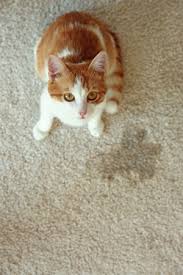How to Clean Urine Stains from Carpet
Ideally, you would catch the culprit who’s peeing on your carpet right away in order to have the most success in not only stopping them, but being able to clean urine stains from carpet right away!

Tools & Chemicals:
Dishwashing or fine fabric detergent, white terry towels, white vinegar, cool water, measuring cup.
Technique:
Work on removing the stain as soon as you notice it. The longer the stain is left on the carpet the greater the chances are of the stain setting.
If the urine is fresh and wet, blot, tamp down and absorb wet urine using a white terry towel. Vacuum any excess dried urine bits or gently scrape up materials with a spoon, if necessary
Mix 1/2 tsp. of dish washing soap or fine fabric detergent into 1 (8 oz.)cup of cool water.
In a small, inconspicuous area, apply a small amount of the cleaning mixture to test that it doesn’t damage or react with the carpet fibers. If there is no damage or reaction, blot or tamp and repeat on the urine spot until the stain is removed. Be patient. Complete removal may require repeating the same step several times. Tamp down on the carpet, do not scrub as this may distort the texture of the pile.
Cover the stain with the towel and press down repeatedly to absorb the stain material and detergent.
Once the stain is completely removed, rinse the area with cold water; blot with a dry white terry towel until all moisture is removed. Repeat this process several times to remove cleaning solution residue. If residue is left on the carpet, it can attract dirt and soils.
If the spot or stain turns brownish when dry, mix 1 part white vinegar and two parts water. Apply a test spot on a small, inconspicuous area of carpet to check for reaction or damage first. If the test spot is fine, then apply a small amount to the stain and blot. Repeat only once.
Precautions:
Never use a stronger concentration than is recommended. Never use laundry detergent or automatic dish washing detergents because they may destroy or dye some fibers.
